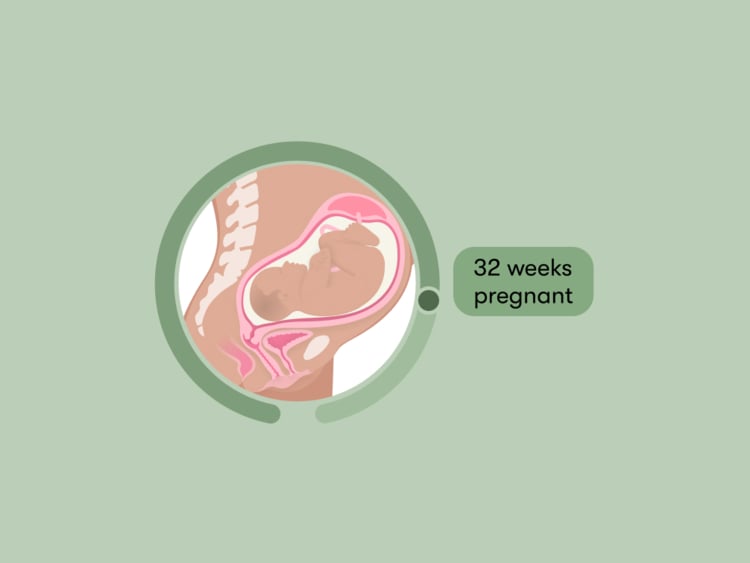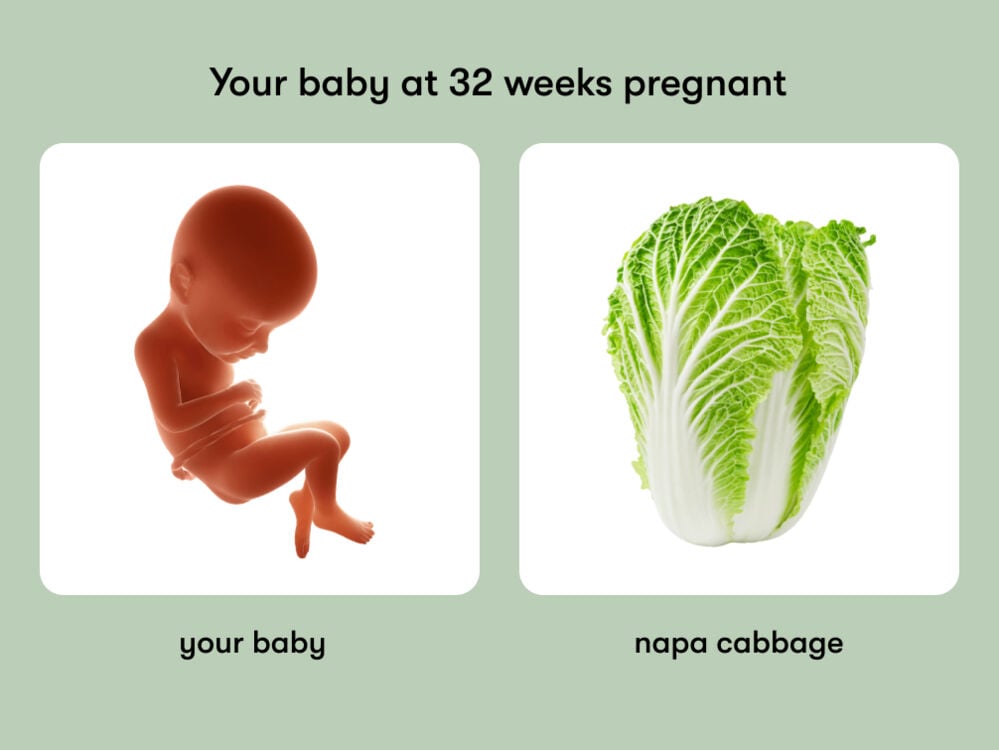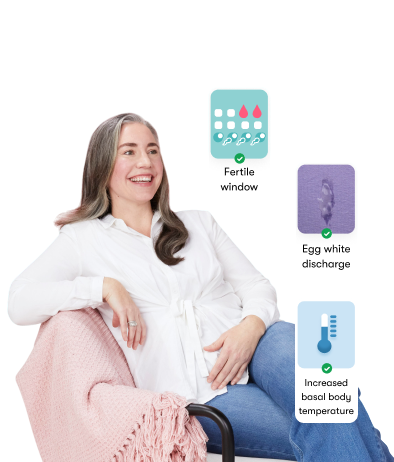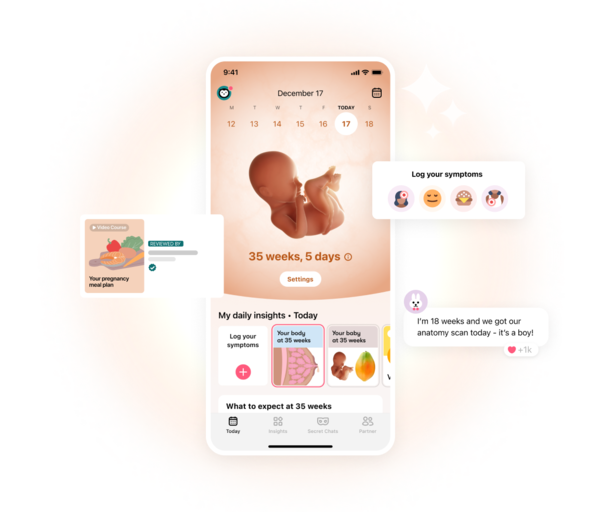From pelvic girdle pain to shopping for postpartum products, here’s the lowdown on being 32 weeks pregnant.
-
Tracking cycle
-
Getting pregnant
-
Pregnancy
-
Help Center
-
Flo for Partners
-
Anonymous Mode
-
Flo app reviews
-
Flo Premium New
-
Secret Chats New
-
Symptom Checker New
-
Your cycle
-
Health 360°
-
Getting pregnant
-
Pregnancy
-
Being a mom
-
LGBTQ+
-
Quizzes
-
Ovulation calculator
-
hCG calculator
-
Pregnancy test calculator
-
Menstrual cycle calculator
-
Period calculator
-
Implantation calculator
-
Pregnancy weeks to months calculator
-
Pregnancy due date calculator
-
IVF and FET due date calculator
-
Due date calculator by ultrasound
-
Medical Affairs
-
Science & Research
-
Pass It On Project New
-
Privacy Portal
-
Press Center
-
Flo Accuracy
-
Careers
-
Contact Us
32 weeks pregnant: Your guide to this week of your third trimester


Every piece of content at Flo Health adheres to the highest editorial standards for language, style, and medical accuracy. To learn what we do to deliver the best health and lifestyle insights to you, check out our content review principles.
At 32 weeks pregnant, you’re well into your third trimester and fast approaching the finish line. It can feel like a lot to think about, from new symptoms to your delivery room plans. To help you navigate all the changes, we’ll explain what might be happening to your baby and body this week with insights from a Flo expert.
Your baby at 32 weeks pregnant
Fully formed liver
Around now, your baby’s liver is fully formed. In fact, at this stage, most of your baby’s organs are completely formed and ready to go. It’s just their lungs and brain that still have some developing to do.
Your baby could be in their birthing position
At 32 weeks, your baby may have settled into their birthing position, although you may not be able to feel the difference. “Many patients aren’t able to tell the position of their baby,” reassures Dr. Jenna Beckham, obstetrician and gynecologist, WakeMed, North Carolina, US. “Sometimes patients will notice more kicking near the ribs or upper abdomen if/when the head is down. There is still time for the baby to get into position at 32 weeks, so a health care provider will usually assess this closer to 35 or 36 weeks.”
So no need to worry if your baby hasn’t found their final position yet, as there’s still plenty of time. From 36 weeks pregnant, your doctor may suggest ways to encourage your little one into the best position for birth. This is head-down and facing your back, with the back of their head ready to enter the pelvis.
While most babies take this head-down position before labor, there are several other possible positions that are good to be aware of. These include transverse lie (when the baby is lying across the uterus) and breech (when the baby is facing feet down toward the birth canal). It’s natural to worry about your baby’s position, as with any other factor that can impact labor. Remember that it’s likely your doctor will have delivered many babies in different positions before and will be happy to discuss any concerns you have.
How big is a baby at 32 weeks?
Length (crown to heel): 43 cm or 16.9 in.
Weight: 2 kg or 4.3 lb.
Size: Equivalent to a napa cabbage
All measurements are approximate and vary within the normal range.

Your body at 32 weeks pregnant
You may develop pelvic girdle pain
You’ve probably not had many reasons to think about your pelvic girdle before, but this ring of bones at the base of your spine can become a frustrating source of pain in pregnancy. As many as one in five pregnant women experience this symptom, so if it affects you, then take some comfort in knowing you’re not alone. But why does it happen? Essentially, as your pregnancy progresses, your growing baby and changes in your posture can cause the three joints in your pelvis to move unevenly. This is perfectly normal and nothing to worry about, but the instability and added strain can cause the area to become painful.
But if you’re experiencing pain down there, how can you tell if it’s pelvic pain or another pregnancy symptom, like round ligament pain? Well, while round ligament pain is an ache or pain on one or both of your sides, if the pain is located around the pubic bone, in the center, and roughly level with your hips, then your pelvic girdle could be the culprit. This type of pain can also be felt across one or both sides of your back or in the area between your vagina and anus. It might also feel as if it’s spreading to your thighs. Some women also experience a clicking or grinding sensation in their pelvis.
Pelvic girdle pain can also get worse following certain movements, including:
- Walking on uneven surfaces or for long distances
- Moving your knees apart, like you do to get in and out of a car
- Putting weight on one leg
- Rolling over in bed
- During sex
Ready for some good news? Pelvic girdle pain is treatable and not something you just have to put up with. Your doctor may offer you an appointment with a physiotherapist, who can give you exercises and equipment (like crutches or pelvic support belts) to help relieve the pain.
Some other things that may help include:
- Wearing supportive shoes
- Staying active but avoiding activities that cause pain, like going up and down stairs
- Sitting down when getting dressed or undressed
- Keeping your knees together when getting in and out of the car (if you can!)
Frequent urination
Have you found yourself needing to pee more often lately? This is a very common pregnancy symptom, and it’s caused by your baby pressing against your bladder. “Some people notice an increase in this in the third trimester, as the baby is getting larger and putting more pressure on the bladder,” explains Dr. Beckham.
Take a quiz
Find out what you can do with our Health Assistant
Your questions answered
Is your baby fully developed at 32 weeks?
Right now, your baby is almost fully formed; they just need to gain some weight. This doesn’t just help make them cute — putting on around a kilogram (approximately 2.2 pounds) of extra fat prevents them from getting too hot or too cold after they’re born — adorable and practical.
Is 32 weeks considered the same as 8 months pregnant?
Wondering how many months pregnant you are at 32 weeks? Well, right now, you are at the end of your eighth month of pregnancy, so you are indeed eight months along. With your baby’s organs now formed, next month will be all about putting the finishing touches on their growth and brain development — an exciting thought!
What should I avoid at 32 weeks pregnant?
Most of the foods and drinks to avoid in your third trimester are no different from the foods and drinks to avoid during pregnancy in general. This includes avoiding alcohol, not drinking more than 200 mg of caffeine a day, and steering clear of foods made from unpasteurized milk.
You may also want to start being more mindful of avoiding foods that can trigger heartburn, as this can be a common symptom in the third trimester. The foods to avoid include citrus fruits, chocolate, and spicy or fried foods — which annoyingly, for many of us, are among the most delicious. If these foods do start bothering you, at least it won’t be long before you can hopefully start enjoying them again.
As with your previous trimesters, you should also avoid certain activities, including scuba diving, contact sports, or exercising at high altitudes (over 2,500 m, or 8,202 feet, above sea level). You may also remember that from 16 weeks pregnant onward, it’s important not to lie flat on your back for long periods, as the pressure from your bump on your blood vessels can make you feel faint.
32 weeks pregnant checklist
Eat a mix of fruits and vegetables
We’re sure you’ve already got your pregnancy diet nailed — but just in case, don’t forget to keep munching on a range of fruit and veggies. Making sure you’ve got a variety of these in your diet means you’ll be getting a diverse range of vitamins, minerals, and fiber.
The quantity matters too: you should aim to eat at least five pieces of fruit and vegetables every day. These could be snacks or part of a main meal where it’s good to make fruit and veggies take up half your plate. Here’s to more colorful mealtimes.
Decide on your delivery room guests
As you continue into your third trimester, you’re probably thinking more and more about labor and delivery. Deciding who to have in the room with you when you give birth (sometimes called birthing partners) is a massive decision, so don’t feel bad if the answer doesn’t come to you right away. If you’re giving birth in a hospital or maternity unit, it’s common to be allowed one to two birthing partners, but this may vary according to the country or area you live in. Whether you choose to have your partner, a family member, or a friend with you, the decision is only yours to make.
Stock up on postpartum products
By now, you may have already amassed a stunning collection of onesies, bonnets, and booties for your baby. But as fun as it can be to shop for your little one, don’t forget to buy yourself a few things too! Ahead of your due date, Dr. Beckham recommends stocking up on the following postpartum items:
- Ice packs to ease any pain or swelling in your perineum (the area between your vagina and anus)
- A numbing spray or cream to ease any pain in your perineum (though it’s best to check with your doctor before using one of these first)
- Medicated cooling pads to relieve pain and help with hemorrhoids
- Maxi pads to help with any vaginal bleeding
- Stool softeners to make it easier to poop (though again, it’s best to check with your doctor before taking these first)
- Nipple cream containing lanolin to soothe sore nipples from breastfeeding
- Comfortable underwear, bras, and pajamas
When to consult a doctor at 32 weeks pregnant
Right now, you may be having a prenatal checkup with your doctor every two weeks. In the final month of your pregnancy, from 36 weeks onward, this may increase to every week. However, how often you see your doctor will depend on where you live, as well as what you and your doctor decide is right for you and your baby.
As well as performing the usual tests, like checking your blood pressure, your doctor may also offer you some vaccinations, including:
- The Tdap vaccine to protect you and your baby from pertussis (sometimes called whooping cough), tetanus, and diphtheria
- The Rho(D) immune globulin vaccine to treat possible blood protein incompatibility
You don’t need to wait until your appointment if you have any concerns or questions about your pregnancy. However, at 32 weeks pregnant, you should contact your doctor immediately if you experience:
- Severe cramping
- Vaginal bleeding
- Changes in vaginal discharge
- Fever
- Dizziness or fainting
- Severe vomiting
- Severe headaches or blurry vision
- Intense heartburn
- A decrease in the amount you feel your baby move
- A loss of liquid from your vagina or watery/mucus-like discharge (This could be a sign of premature labor.)
This isn’t an exhaustive list but just some examples of changes you should look for. Some of these can be a sign of health complications, so it’s essential that you speak to your doctor about the best next step for you. And if you’re worried about any other symptoms you experience during pregnancy, don’t hesitate to reach out to your health care provider.
32 weeks pregnant: The takeaway
At 32 weeks pregnant, your baby is almost ready to meet you! Now is a great time to focus on yourself, from thinking about your delivery room guests to stocking up on postpartum supplies. Future you will love you for it.


Hey, I'm Anique
I started using Flo app to track my period and ovulation because we wanted to have a baby.


The Flo app helped me learn about my body and spot ovulation signs during our conception journey.


I vividly
remember the day
that we switched
Flo into
Pregnancy Mode — it was
such a special
moment.
Real stories, real results
Learn how the Flo app became an amazing cheerleader for us on our conception journey.
References
“Week 32.” NHS, www.nhs.uk/start4life/pregnancy/week-by-week/3rd-trimester/week-32/. Accessed 11 July 2023.
“3rd Trimester Pregnancy: What to Expect.” Mayo Clinic, 9 Mar. 2022, www.mayoclinic.org/healthy-lifestyle/pregnancy-week-by-week/in-depth/pregnancy/art-20046767.
“Bleeding during Pregnancy.” The American College of Obstetricians and Gynecologists, May 2021, www.acog.org/womens-health/faqs/bleeding-during-pregnancy.
“Exercise in Pregnancy.” NHS, www.nhs.uk/pregnancy/keeping-well/exercise/. Accessed 11 July 2023.
“Fetal Development.” Cleveland Clinic, my.clevelandclinic.org/health/articles/7247-fetal-development-stages-of-growth. Accessed 15 June 2023.
Curran, Mark A. “Fetal Development.” Perinatology.com, perinatology.com/Reference/Fetal%20development.htm. Accessed 11 July 2023.
“Fetal Positions for Birth.” Cleveland Clinic, my.clevelandclinic.org/health/articles/9677-fetal-positions-for-birth. Accessed 26 June 2023.
“Foods to Avoid in Pregnancy.” NHS, www.nhs.uk/pregnancy/keeping-well/foods-to-avoid/. Accessed 11 July 2023.
“Frequent Urination.” Cleveland Clinic, my.clevelandclinic.org/health/symptoms/15533-frequent-urination. Accessed 11 July 2023.
Friel, Lara A. “Fevers during Pregnancy.” MSD Manual Consumer Version, Oct. 2021, www.msdmanuals.com/home/women-s-health-issues/pregnancy-complicated-by-disease/fevers-during-pregnancy.
Giancotti, Antonella, et al. “Functions and the Emerging Role of the Foetal Liver into Regenerative Medicine.” Cells, vol. 8, no. 8, Aug. 2019, https://doi.org/10.3390/cells8080914.
“Have a Healthy Diet in Pregnancy.” NHS, www.nhs.uk/pregnancy/keeping-well/have-a-healthy-diet/. Accessed 5 July 2023.
“Hemorrhoids.” Mayo Clinic, 12 May 2021, www.mayoclinic.org/diseases-conditions/hemorrhoids/diagnosis-treatment/drc-20360280.
“Hospital Birth Centre (Labour Ward).” Guy’s and St Thomas’ NHS Foundation Trust, www.guysandstthomas.nhs.uk/our-wards/hospital-birth-centre-labour-ward. Accessed 11 July 2023.
“Pregnant? Here’s How Often You’ll Likely See Your Doctor.” Cleveland Clinic, 14 Jan. 2022, health.clevelandclinic.org/prenatal-appointment-schedule/.
“Pelvic Girdle Pain and Pregnancy.” Royal College of Obstetricians & Gynaecologists, www.rcog.org.uk/for-the-public/browse-all-patient-information-leaflets/pelvic-girdle-pain-and-pregnancy/. Accessed 11 July 2023.
“Kick Counts.” Cleveland Clinic, my.clevelandclinic.org/health/articles/23497-kick-counts. Accessed 14 June 2023.
“Lanolin.” Drugs and Lactation Database (LactMed®). National Institute of Child Health and Human Development, 15 May 2023, www.ncbi.nlm.nih.gov/books/NBK501842/.
“Morning Sickness: Nausea and Vomiting of Pregnancy.” The American College of Obstetricians and Gynecologists, May 2020, www.acog.org/womens-health/faqs/morning-sickness-nausea-and-vomiting-of-pregnancy.
“Nutrition during Pregnancy.” The American College of Obstetricians and Gynecologists, June 2023, www.acog.org/womens-health/faqs/nutrition-during-pregnancy.
“Pelvic Pain in Pregnancy.” NHS, www.nhs.uk/pregnancy/related-conditions/common-symptoms/pelvic-pain/. Accessed 11 July 2023.
“Postpartum Pain Management.” The American College of Obstetricians and Gynecologists, Oct. 2020, www.acog.org/womens-health/faqs/postpartum-pain-management#.
“Heartburn during Pregnancy.” Cleveland Clinic, my.clevelandclinic.org/health/diseases/12011-heartburn-during-pregnancy. Accessed 14 June 2023.
“Preterm Labor.” Mayo Clinic, 8 Feb. 2022, www.mayoclinic.org/diseases-conditions/preterm-labor/symptoms-causes/syc-20376842.
“Round Ligament Pain.” Cleveland Clinic, my.clevelandclinic.org/health/symptoms/21642-round-ligament-pain. Accessed 11 July 2023.
“Urgent Maternal Warning Signs.” Centers for Disease Control and Prevention, www.cdc.gov/hearher/maternal-warning-signs/index.html. Accessed 13 July 2023.
“Vaginal Discharge in Pregnancy.” NHS, www.nhs.uk/pregnancy/related-conditions/common-symptoms/vaginal-discharge/. Accessed 14 June 2023.
History of updates
Current version (25 August 2023)
Published (24 February 2019)
In this article

Get your personal guide to pregnancy with the Flo app
-
Follow your baby's growth week by week
-
Get expert info on symptoms, safe foods, and more
-
Chat with other parents-to-be




